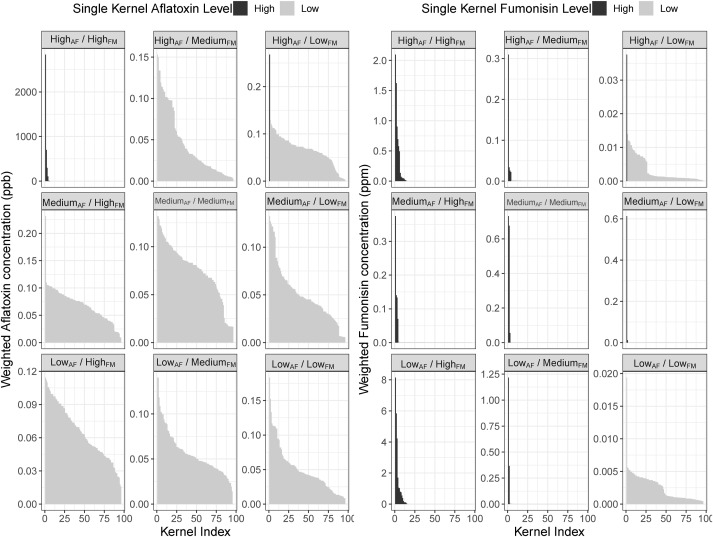Highlights
- Uses a UV–Vis–NIR spectroscopy system to scan single corn kernels in motion.
- Presents aflatoxin and fumonisin single kernel contamination distributions.
- Stochastic gradient boosting best classifies single kernels by aflatoxin level.
- Penalized discriminant analysis best classifies single kernels by fumonisin level.
Abstract
Aflatoxin and fumonisin contamination distribution in corn is non-homogeneous. Therefore, bulk sample testing may not accurately represent the levels of contamination. Single kernel analysis could provide a solution to these problems and lead to remediation strategies such as sorting. Our study uses extensive single kernel aflatoxin (AF) and fumonisin (FM) measurements to (i) demonstrate skewness, calculate weighted sums of toxin contamination for a sample, and compare those values to bulk measurements, and (ii) improve single kernel classification algorithm performance. Corn kernels with natural contamination of aflatoxin and fumonisin (n = 864, from 9 bulk samples) were scanned individually twice for reflectance between the ultraviolet–visible–near infrared spectrum (304 nm–1086 nm), then ground and measured for aflatoxin and fumonisin using ELISA. Single kernel contamination distribution was non-homogeneous with 1.0% (n = 7) of kernels with ≥20 ppb aflatoxin (range 0 – 4.2×105 ppb), and 5.0% (n = 45) kernels with ≥2 ppm fumonisin (range 0 – 7.0×102 ppm). A single kernel weighted sum was calculated and compared to bulk measurements. Average difference in mycotoxin levels (AF = 0.0 log(ppb), FM = 0.0 log(ppm), weighted sum – measured bulk levels) calculated no systematic bias between the two methods, though with considerable range of −1.4 to 0.7 log(ppb) for AF and −0.6 to 0.8 log(ppm) for FM. Algorithms were trained on 70% of the kernels to classify aflatoxin (≥20ppb) and fumonisin (≥2ppm), while the remaining 30% of kernels were used for testing. For aflatoxin, the best performing algorithm was stochastic gradient boosting model with an accuracy of 0.83 (Sensitivity (Sn) = 0.75, Specificity (Sp) = 0.83), for both training and testing set. For fumonisin, the penalized discriminant analysis outperformed the rest of the algorithms, with a training accuracy of 0.89 (Sn = 0.87, Sp = 0.88), and testing accuracy of 0.86 (Sn = 0.78, Sp = 0.87). The present study improves the foundations for single kernel classification of aflatoxin and fumonisin in corn, and can be applied to high throughput screening. This study demonstrates the heterogeneous distribution of aflatoxin and fumonisin contamination at single kernel level, comparing bulk levels calculated from those data to traditional bulk tests, and utilizing a UV–Vis–NIR spectroscopy system to classify single corn kernels by aflatoxin and fumonisin level.

